
The Warsaw Uprising, sometimes referred to as the August Uprising, was a major World War II operation by the Polish underground resistance to liberate Warsaw from German occupation. It occurred in the summer of 1944, and it was led by the Polish resistance Home Army. The uprising was timed to coincide with the retreat of the German forces from Poland ahead of the Soviet advance. While approaching the eastern suburbs of the city, the Red Army halted combat operations, enabling the Germans to regroup and defeat the Polish resistance and to destroy the city in retaliation. The Uprising was fought for 63 days with little outside support. It was the single largest military effort taken by any European resistance movement during World War II. The defeat of the uprising and suppression of the Home Army enabled the pro-Soviet Polish administration, instead of the Polish government-in-exile based in London, to take control of Poland afterwards. Poland would remain as part of the Soviet-aligned Eastern Bloc throughout the Cold War until 1989.

Around six million Polish citizens are estimated to have perished during World War II. Most were civilians killed by the actions of Nazi Germany, the Soviet Union, the Lithuanian Security Police, as well as the Organization of Ukrainian Nationalists and its offshoots.

Mokotów Prison is a prison in Warsaw's borough of Mokotów, Poland, located at 37 Rakowiecka Street. It was built by the Russians in the final years of the foreign Partitions of Poland. During the Nazi German occupation and later, under the communist rule, it was a place of detention, torture and execution of the Polish political opposition and underground fighters. The prison continues to function, holding prisoners awaiting trial or sentencing, or those being held for less than one year.
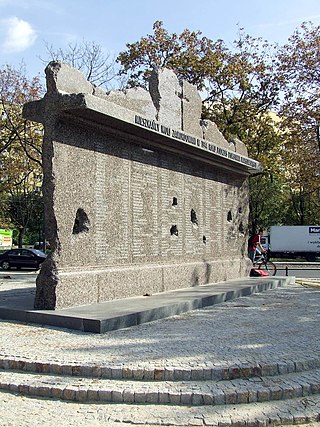
Crimes against the Polish nation committed by Nazi Germany and Axis collaborationist forces during the invasion of Poland, along with auxiliary battalions during the subsequent occupation of Poland in World War II, included the genocide of millions of Polish people, especially the systematic extermination of Jewish Poles. These mass killings were enacted by the Nazis with further plans that were justified by their racial theories, which regarded Poles and other Slavs, and especially Jews, as racially inferior Untermenschen.

Rainer Joseph Karl August Stahel was a German military officer and war criminal. He is best known for his retreat from Vilna and the command of the garrison of Warsaw during the Warsaw Uprising of 1944. Arrested by the NKVD in Romania, he spent the rest of his life in Soviet captivity.

The Ochota massacre was a wave of German-orchestrated mass murder, looting, arson, torture and rape, which swept through the Warsaw district of Ochota from 4–25 August 1944, during the Warsaw Uprising. The principal perpetrators of these war crimes were the Nazi collaborationist S.S. Sturmbrigade R.O.N.A., the so-called "Russian National Liberation Army", commanded by Bronislav Kaminski.

Verbrennungskommando Warschau was a slave labour unit formed by the SS following the Wola massacre of around 40,000 to 50,000 Polish civilians by the Germans in the early days of the Warsaw Uprising of 1944.
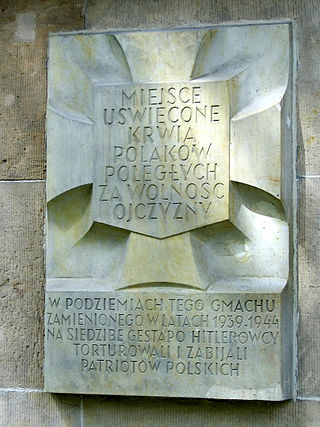
Tchorek plaques are a common design of memorial plaque in Warsaw, Poland, used to commemorate places where battles or executions took place during the German occupation of the city during World War II. They are based on an original design by sculptor Karol Tchorek from 1949.
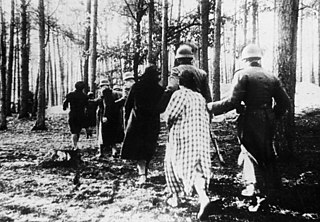
The Palmiry massacre was a series of mass executions carried out by Nazi German forces, during World War II, near the village of Palmiry in the Kampinos Forest northwest of Warsaw.
Executions in the ruins of the Warsaw Ghetto (1943–1944) – mass executions of Polish Political prisoners and people of Jewish descent carried out secretly by German occupiers in the ruins of the Warsaw Ghetto.

The execution at Powązkowska Street - a mass murder of 22 Warsaw residents of Powązki by the Germans on 1 August 1944. This execution, which claimed the lives of men living in a house at 41 Powązkowska Street, was one of the first German crimes committed during the suppression of the Warsaw Uprising.

The massacre at 111 Marszałkowska Street - a crime against the civilian population of Warsaw committed by the Germans during the Warsaw Uprising. On August 3, 1944, next to the "Pod Światełkami" tavern, the crew of a German armoured car shot about 30-44 Polish civilians - residents of tenement houses on Marszałkowska Street No. 109, 111, 113.

Stauferkaserne prison was a provisional prison, and at the same time a gathering point for expelled Warsaw residents, established by the Germans during the first days of the Warsaw Uprising on the grounds of the SS-Stauferkaserne barracks at 4 Rakowiecka Street. In August and September 1944 over a thousand residents of the district passed through the SS barracks in Mokotów. They were detained there in harsh conditions and were subjected to extremely brutal treatment. During the Warsaw Uprising, the Stauferkaserne area was the scene of numerous executions, the victims of which were at least 100 people.

The Suppression of Mokotów was a wave of mass murders, looting, arson and rapes that swept through the Warsaw district of Mokotów during the Warsaw Uprising in 1944. Crimes against prisoners of war and civilians of the district were committed by the Germans until the capitulation of Mokotów on September 27, 1944, although they intensified in the first days of the uprising.
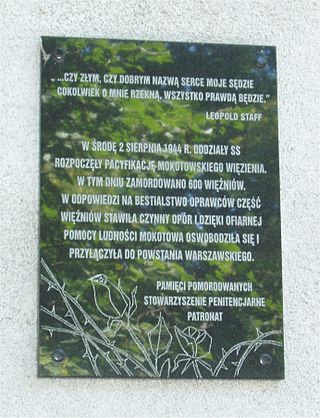
The Massacre in the Mokotów prison was a mass murder of residents of the Mokotów Prison in Warsaw by the Germans on the second day of the Warsaw Uprising. On August 2, 1944, soldiers of the Waffen-SS - SS-Pz. Gren. Ausb.-und Ers. Btl. 3 shot about 600 Poles on the premises of the prison at 37 Rakowiecka Street. It was one of the biggest crimes committed by the Germans in Mokotów during the suppression of the Warsaw Uprising. During the massacre, some prisoners actively resisted the Nazis, which allowed several hundred people to escape to the area controlled by the insurgents.

During the German invasion of Poland, which started World War II, Nazi Germany carried out a number of atrocities involving Polish prisoners of war (POWs). During that period, the Wehrmacht is estimated to have mass-murdered at least 3,000 Polish POWs, with the largest atrocities being the Ciepielów massacre of 8 September 1939 and the Zambrów massacre of 13–14 September. Most of those atrocities are classified as war crimes of the Wehrmacht. Jewish soldiers with the Polish Army were also more likely than others to be victims of various atrocities.
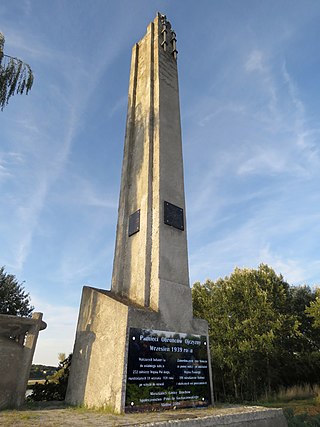
The Śladów massacre, occurring on September 18, 1939, near the village of Śladów, was a war crime committed by the Wehrmacht during its invasion of Poland. On that day, a large group of Polish prisoners of war and civilian hostages were either shot or drowned in the Vistula River. According to the majority of Polish sources, the number of victims reached 300; however, this figure may have been exaggerated.

Dulag 121 camp in Pruszków was a Nazi transit camp where civilian population from Warsaw and surrounding areas, expelled from their homes during and after the Warsaw Uprising, was gathered.

South Downtown is a neighbourhood in Warsaw, Poland, located in the Downtown district. It is mainly a mid-rise residential area, predominantly consisting of tenements and multifamily residential buildings, as well as office and commercial spaces.

Executions in Warsaw's police district were mass executions of residents from Warsaw's Śródmieście and southern districts, carried out by the Germans during the Warsaw Uprising in the so-called police district in South Downtown.






















